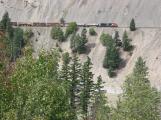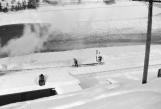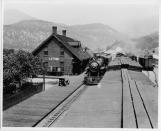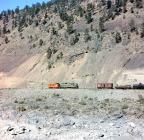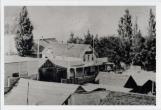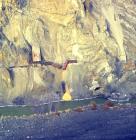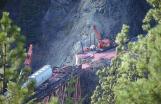15
The trains made transportation easier, quicker and more reliable.Local people were more able to get out of Lytton, and visitors had easier access.
An early timetable (1884) showed a trip from Lytton to Port Moody:
Train leaves Lytton at 5AM
Arrives at Port Moody at 7:15 PM
Two 1 hour meal stops
Travel time: 14 hours, 15 min.
Av. Speed: 12 MPH
In 1928 Lytton was used as the filming location for a feature film called ‘The Winds of Chance', based on a popular novel by Rex Beach. There was no theater in Lytton, but Art Kent, a local, reminisced that he went by train to Ashcroft to see it, as the roads were not dependable.
The cast and crew lived in a chartered train on a siding in Lytton.
Cattle and farm produce were shipped by train. Cattle pens were built in the CPR yards at Lytton.
Trains allowed visitors to travel more easily. Among those stopping in Lytton were the King and Queen of England and the King and Queen of Siam.
Local trains delivered passengers and supplies to all of the settlements along the route. These were slow trains due to the frequent stops, but they gave a much needed service to smaller centres. The trainmen and passengers often knew each other and this familiarity developed a strong sense of neighbourliness.
There are presently no scheduled stops for any trains, passenger or freight, in Lytton. Anyone wishing to travel by train must first travel by road many miles to a larger centre to catch the train that passes through the Village.
17
The last scheduled steam powered train on the Canadian National Railway leaves Lytton.1959
Lytton, BC
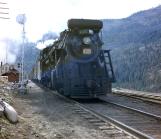
19
Early diesel locomotives pulling a train over a stone retaining wall on the Candian Pacific Railway.1960
Near Lytton, BC
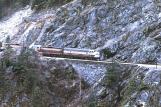
20
Employment at this time:The payrolls which contributed at one time to Lytton's economy have been reduced or eliminated. Stations have been closed and agents and families have moved from our community. Track patrols, maintenance crews and section gangs have all but disappeared.
Work is now done by special crews who come to town for limited periods of time which occur spasmodically. While these visiting workers do help businesses, they certainly do not take the place of the former crews in the Village economy.
Both the CNR and the CPR have contributed old track maintenance cars (speeders) to the Museum collection. The CNR Bridge and Building gang donated historical items from their collection when their building was vacated.
The Village was fortunate in receiving a caboose from the CNR when cabooses were no longer used. This car has become a railway interpretive centre for the Fraser Canyon. We are thankful that this memorabilia has been presented to the Village.
21
A modern Canadian National train using the Canadian Pacific track.29 August 2004
Near Lytton, BC
